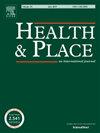邻里社会凝聚力,孤独和多病:来自英国纵向面板研究的证据。
IF 3.8
2区 医学
Q1 PUBLIC, ENVIRONMENTAL & OCCUPATIONAL HEALTH
引用次数: 0
摘要
在人口老龄化的背景下,多病是一个日益普遍的公共卫生问题,对个人和卫生保健系统都有重大影响。除了在个人层面上研究风险因素的文献外,越来越多的研究调查了社区在多重疾病发展中的作用。然而,这些工作大多集中在空气污染和绿色空间等地方的物理特征上,而地方的社会特征在很大程度上被忽视了。因此,在这项研究中,我们探讨了邻里凝聚力作为一种社会邻里特征,可能会影响多病风险。此外,我们分析了孤独如何有助于解释邻里凝聚力和多重疾病之间的关系,因为孤独在个体水平的研究中是多重疾病的重要危险因素。利用英国家庭纵向面板研究“理解社会”(Understanding Society),我们对大约40,000个家庭进行了多水平横断面和纵向分析,以建立这些关系的模型。我们发现,更强的邻里凝聚力与更低的多病风险之间存在实质性关联(凝聚力第二强的五分位数与凝聚力最低的五分位数的比值比(OR) = 0.75, p本文章由计算机程序翻译,如有差异,请以英文原文为准。
Neighbourhood social cohesion, loneliness and multimorbidity: Evidence from a UK longitudinal panel study
In the context of population ageing, multimorbidity is an increasingly prevalent public health issue that has a substantial impact on both individuals and healthcare systems. Alongside the literature looking at risk factors at the individual level, there is a growing body of research examining the role of neighbourhoods in the development of multimorbidity. However, most of this work has focused on physical features of place such as air pollution and green space, while social features of place have been largely overlooked. In this study, we therefore explored neighbourhood cohesion as a social neighbourhood characteristic that could influence multimorbidity risk. Additionally, we analysed how loneliness may help to explain any relationship between neighbourhood cohesion and multimorbidity, given the emergence of loneliness as an important risk factor for multimorbidity in individual-level studies. Using Understanding Society, a UK household longitudinal panel study of approximately 40,000 households, we conducted both multilevel cross-sectional and longitudinal analyses to model these relationships. We found that there is a substantial association between greater neighbourhood cohesion and lower multimorbidity risk (odds ratio (OR) for second most cohesive quintile versus least cohesive quintile = 0.75, p < .01), even after controlling for a wide range of socio-economic factors, health behaviours and physical features of place. This cross-sectional result was confirmed by longitudinal analysis of individuals with no health conditions at baseline who moved between neighbourhoods over a nine-year follow-up period. Movers who experienced a decrease in cohesion had greater odds of becoming multimorbid compared to movers who did not experience a decrease in cohesion (OR = 1.68, p = .057). Controlling for loneliness substantially attenuates the odds ratios for neighbourhood cohesion, and in a mediation analysis we found a significant indirect effect of neighbourhood cohesion on multimorbidity risk acting through loneliness, suggesting it is a plausible mechanism through which the social environment influences the development of multiple long-term health conditions.
求助全文
通过发布文献求助,成功后即可免费获取论文全文。
去求助
来源期刊

Health & Place
PUBLIC, ENVIRONMENTAL & OCCUPATIONAL HEALTH-
CiteScore
7.70
自引率
6.20%
发文量
176
审稿时长
29 days
期刊介绍:
he journal is an interdisciplinary journal dedicated to the study of all aspects of health and health care in which place or location matters.
 求助内容:
求助内容: 应助结果提醒方式:
应助结果提醒方式:


